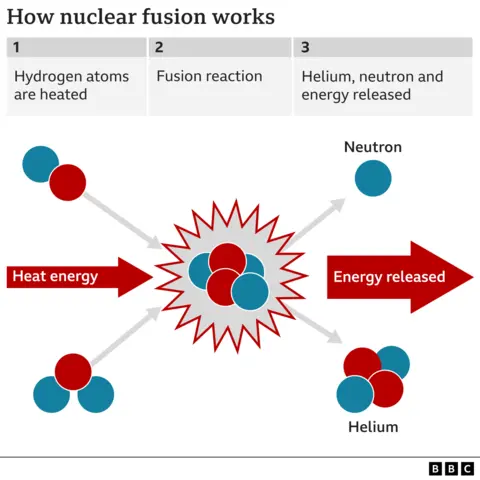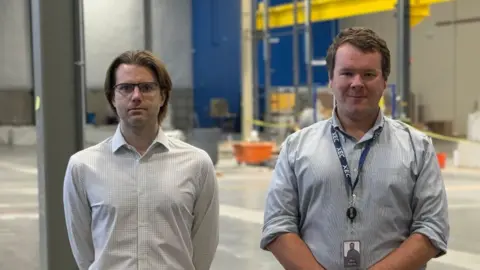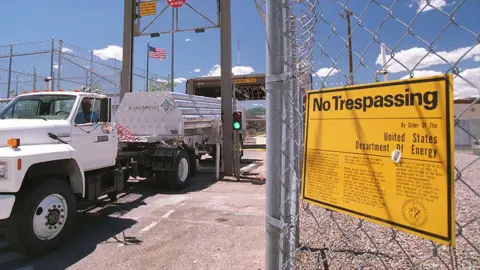 Damien Jemison
Damien JemisonDeep underneath the Nevada desert within the Eighties the US carried out secret nuclear weapons analysis.
Among the many experiments was an effort to see if nuclear fusion, the response which powers the solar, may very well be sparked on earth in a managed setting.
The experiments had been labeled, nevertheless it was broadly recognized amongst physicists that the outcomes had been promising.
That data caught the eye of two younger graduate college students working on the Los Alamos Nationwide Laboratory within the late 2000s, Conner Galloway and Alexander Valys.
The Los Alamos lab was initially arrange in 1943 as a top-secret web site to develop the primary nuclear weapons. Situated close to Santa Fe, New Mexico it’s now a US authorities analysis and improvement facility.
“When Alex and I realized about these exams at Los Alamos, our response was like ‘wow, inertial fusion has already labored!’. Laboratory-scale pellets had been ignited, the main points had been labeled, however sufficient was made public that we knew that ignition was achieved,” says Mr Galloway.
Nuclear fusion is the method of fusing hydrogen nuclei collectively, which produces immense quantities of power. The response creates helium and never the long-lived radioactive waste of the fission course of which is utilized in current nuclear energy stations.
If fusion could be harnessed, then it guarantees ample electrical energy, generated with out producing CO2.
These exams within the Eighties led to the US authorities constructing the Nationwide Ignition Facility (NIF) in California, a mission to see if nuclear gasoline pellets may very well be ignited utilizing a robust laser.
After greater than a decade of labor, in late 2022 researchers at NIF made a breakthrough. Scientists carried out the primary managed fusion experiment to provide extra power from the response than that provided by the lasers which sparked it.

Whereas physicists around the globe marvelled at that breakthrough, it had taken the scientists at NIF for much longer than anticipated.
“They had been power starved,” says Mr Galloway.
He doesn’t suggest they wanted extra snacks, as a substitute the NIF laser was solely simply highly effective sufficient to ignite the gasoline pellet.
Mr Galloway and Mr Valys assume that extra highly effective lasers will make it potential to construct a working fusion response that may provide electrical energy to the facility grid. To do this they based Xcimer, primarily based in Denver.
NIF needed to make do with a laser that might pump out two megajoules of power. Mr Galloway and Mr Valys are planning to experiment with lasers that may provide as much as 20 megajoules of power.
“We expect 10 to 12 [megajoules] is the candy spot for a industrial energy plant,” says Mr Galloway.
Such a laser beam would hit the gasoline capsule with a robust punch. It could be like taking the power of a 40-tonne articulated lorry travelling at 60mph and focussing it on the centimetre-sized capsule for a couple of billionths of a second.
Extra highly effective lasers will permit Xcimer to make use of bigger and easier gasoline capsules than NIF, which discovered it tough to excellent them.
 Xcimer
XcimerXcimer joins dozens of different organisations around the globe making an attempt to construct a working fusion reactor.
There are two principal approaches. Smashing a gasoline pellet with lasers falls underneath the class of inertial confinement fusion.
The opposite manner, generally known as magnetic confinement fusion, makes use of highly effective magnets to entice a burning cloud of atoms referred to as plasma.
Each approaches have daunting engineering challenges to beat.
Particularly, how do you extract the warmth generated throughout fusion so you are able to do one thing helpful with it, like drive a turbine to make electrical energy?
“I suppose my scepticism is, I have not but even seen a persuasive conceptual diagram of the way you handle the method of taking power out whereas holding the fusion response going,” says Prof Ian Lowe at Griffith College in Australia.
He has spent his lengthy profession working in power analysis and coverage. Whereas Prof Lowe helps the event of fusion expertise, he simply argues {that a} working fusion reactor will not come quick sufficient to assist deliver down CO2 emissions and deal with local weather change.
“My concern is that even probably the most optimistic view is that we would be fortunate to have industrial fusion reactors by 2050. And lengthy earlier than then we have to have decarbonized the power provide if we’re not going to soften the planet,” he says.
One other problem is that the fusion response produces excessive power particles that may degrade metal, or some other materials that strains the reactor core.
 Getty Pictures
Getty PicturesThese within the fusion business do not deny the engineering challenges, however really feel they are often overcome.
Xcimer plans to make use of a “waterfall” of molten salt flowing across the fusion response to soak up the warmth.
The founders are assured that they’ll hearth the lasers and exchange the gasoline capsules (one each two seconds) whereas holding that circulation going.
The circulation of molten salt can even be thick sufficient to soak up excessive power particles that might probably harm the reactor.
“We simply have two comparatively small laser beams coming in from both aspect [of the fuel pellet]. So that you solely want a niche within the circulation large enough for these beams, and so you do not have to show off and activate your complete circulation,” says Mr Valys.
However how rapidly can them make such a system work?
Xcimer plans to experiment with the lasers for 2 years, earlier than constructing a goal chamber, the place they’ll goal the gasoline pellets.
The ultimate stage can be the working reactor, which they hope can be plugged into the electrical energy grid within the mid-2030s.
To fund the primary section of their work, Xcimer has raised $100m (£77m) . The cash can be used to construct a facility in Denver and the prototype laser system.
Tons of of hundreds of thousands {dollars} extra can be wanted to construct a working reactor.
However for the founders of Xcimer, and different fusion start-ups, the prospect of low cost, carbon-free electrical energy is irresistible.
“You recognize, it’s going to change the trajectory of what is potential for humanity’s progress,” says Mr Valys.




